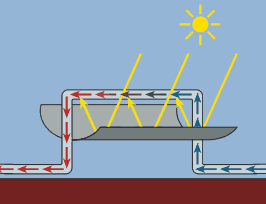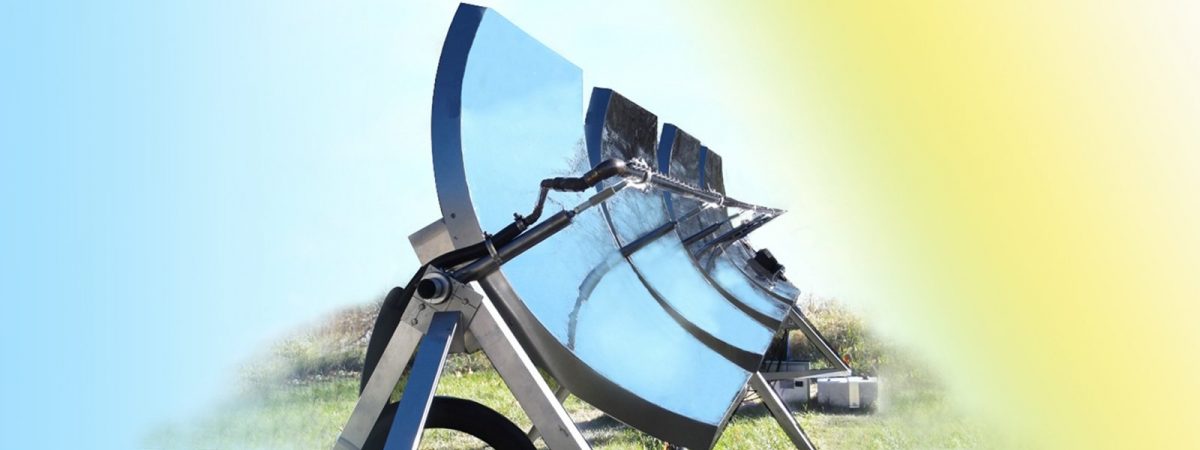Electricity from the grid
Money Payback:
If you are paying $.30 kWh on the Electricity grid and then use the solar trough 300 days per year, it could save you 81,000 kWh. As a result, you will save approx. $24,300 per year.
(In the case for climate change) According to the US energy Information: It takes 1.64 pounds of CO2 to make 1 kWh of electricity (Based on using #2 oil). Using solar could eliminate (132,840 pounds of CO2 each year).

Fuel Oil:
If you are paying $7.00 gallon for oil and burn the oil in a 80% boiler and use it for 300 days per year, you would use 2469 gallons of oil. Using the Parabolic solar trough as a result would save you $17,283 per year.
(In the case for climate change) According to the US energy Information. Using a trough would eliminate (55,256 pounds of CO2 per year).
Heating And Cooling Renewable
Industrial Process Heat
The United States’ industrial sector uses heat for a wide variety of applications, including washing, cooking, sterilizing, drying, preheating of boiler feed water, process heating, and much more. Altogether, the industrial sector uses and estimated 24 quadrillion Btu, or roughly one-third of the nation’s delivered energy supply.1 Process heating applications alone account for approximately 36 percent of total delivered energy consumption within the manufacturing sector (a subset of the industrial sector).2 The vast size and scale of industrial heating energy use represents a unique opportunity for renewable resources.
According to a study of industrial heating in European countries, 30 percent of industrial heating applications require heat below 212°F, another 27 percent can be met with heat between 212 and 750°F, and the remaining 43 percent require heat above 750°F.3 Most existing renewable heating technologies can easily and cost-effectively supply heat within the lowest indicated temperature range. Often, the most valuable role that renewable heating technologies can play in industrial applications is to provide “pre-heating” before an existing conventional energy source is used. Major considerations for industrial renewable heating applications include cost, resource intermittency, and process integration and storage options.
How Renewable Industrial Process Heat Works
Solar, geothermal, or biomass sources can provide heat to support industrial processes that serve water- or air-heating end uses. As described above, more than half of industrial heating is met through temperatures below 750°F, and some industries (agriculture, cooking) have much lower temperature needs. Many renewable heating resources can easily meet the lower temperature requirements. Even if renewable sources cannot support the entire heating load, they can still provide pre-heating to supplement a conventional heating process. Because it takes a relatively large amount of energy to raise the temperature of water (compared with heating air, for example), even a modest amount of pre-heating can reduce a facility’s dependence on fossil fuels—and save money in the process.
Compatible Renewable Technologies
Flat-plate solar collectors and ground source heat pumps can support industrial processes requiring warm to hot water, such as pressurization or pre-heating water. Many agricultural processes also require gentle warming. For example, flat-plate solar collectors and ground source heat pumps can help to warm soil or warm water for fish farming to about 100°F.
Chemical processing, kilning, drying, curing, sterilization, and distillation activities requiring higher temperatures can use evacuated tube solar collectors, direct use geothermal water, or biomass furnaces. Concentrating solar thermal technologies and deep geothermal wells can support the highest-temperature applications, such as fuel production, that require pressurized, superheated water or steam above 480°F.
Agricultural and industrial facilities often take advantage of co-location and cogeneration. Waste agricultural products such as rice and corn husks can potentially serve as effective biomass fuels. Similarly, waste heat from a high-temperature industrial process can possibly support another process requiring a lower temperature.

